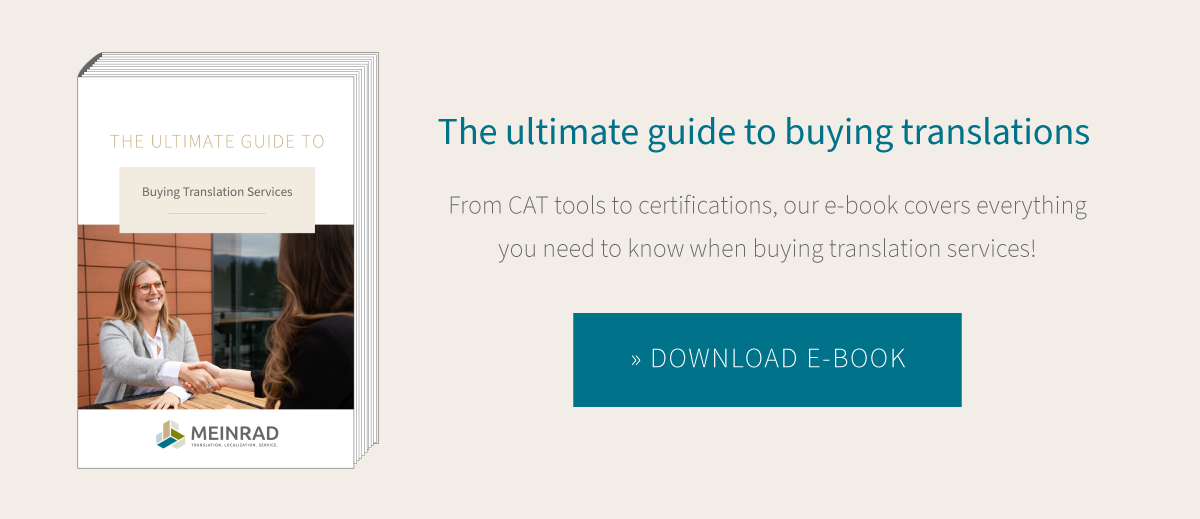
Translation agencies offer a wide range of services, including human translation, machine translation with post-editing, translation with revision and transcreation. But what’s the right choice for which texts?
You order translations from a translation agency. So far so obvious – but in the real world getting the end product can be a bit more complicated than that, because there are lots of different service levels when it comes to producing a text in another language. The most common services offered by translation agencies are:
- Machine translation with full post-editing
- Human translation
- ISO 17000 translation with review
- Transcreation
How the translators work depends on which service you choose. Although the result is always a translated text, there may be slight variations in terms of the level of linguistic perfection. So it’s important for them to know what you need and expect so that you get what you’re looking for.
Machine translation with full post-editing
| Particularly suitable for: |
Texts with “neutral” language and short sentences, where safety is not a major factor or there are no particularly high requirements in terms of phrasing. Texte mit „neutraler“ Sprache und kurzen Sätzen, die nicht besonders sicherheitskritisch sind oder keine hohen Anforderungen an die Formulierung stellen |
| Cost factor: | |
| Time factor: |
Machine translation arrived on the scene a few years ago – and it’s here to stay. Machine translation software has got better and better over time, and it can now be used in a professional environment to produce high-quality results in lots of languages. But bear in mind that machine translation alone won’t cut the mustard if you’re translating documents such as operating instructions, so it should only be used in conjunction with professional post-editing. It works as follows: the software translates the texts in a matter of seconds, then a human specialist translator goes through the output with a fine-tooth comb, making the necessary changes and ensuring that the specific terminology required by the client has been used.
Top tip: Make sure your translation agency is ISO 18587 certified. A key requirement of this standard is that the output of the machine translation and post-editing process must be comparable in quality to a human translation.
Human translation
| Particularly suitable for: |
All kinds of texts with complex terminology or challenging syntax; texts with little context (e.g. lists with separate entries); texts which require minimal creativity in translation |
| Cost factor: | |
| Time factor: |
Human translation is the classic service provided by translation agencies. A professional specialist translator produces a translation of the source text in their own native language using advanced translation technology such as CAT tools with built-in translation memories. They use the client’s specific terminology, ensure their translations are consistent, and produce a target-language text with correct grammar, spelling and syntax that includes all the information contained in the source text. The result is a high-quality translation. Human translations are suitable for all kinds of texts, unless a huge amount of creativity is required.
ISO 17000 translation with review
| Particularly suitable for: | Safety-critical and sensitive texts |
| Cost factor: | |
| Time factor: |
The “Translation with review” service begins with a human translation produced by an experienced specialist translator (as described above). The text is then reviewed by another specialist translator, who in accordance with ISO 17100 must meet the same strict criteria as the translator. The reviewer’s job is to check that the text has been translated correctly by comparing the source text with the target text, and if necessary correct any mistakes or typos and improve the phrasing. As this involves another person, the review will of course add to the time required for producing the final text (around 50% more than a translation without review, in fact). This step serves as additional assurance against errors in the text you get back – after all, two heads are better than one. So we recommend this service if the texts to be translated are particularly sensitive and you need to minimize the risks as much as possible (e.g. contracts, texts for products where there is a risk of personal injury, etc.).
Transcreation
| Particularly suitable for: | Marketing and advertising texts and slogans; all texts where the purpose is to “sell” |
| Cost factor: | |
| Time factor: |
One thing the services we’ve discussed so far have in common is that the translators stick very closely to the source texts when producing their translations. But this isn’t always the right approach for certain types of text. We’re talking about advertising texts and marketing texts: in short, all texts where the aim is to convince people to buy a product or service. What matters most here is that the text is tailored perfectly to the target audience, and transcreation is the way to do it. Transcreation gives the translator more freedom – their priority is to convey the same message rather than simply reproducing the words of the source text. It has to resonate with the target audience, which may mean completely rephrasing a slogan or text, leaving bits out or coming up with new ideas. As you’d expect, this form of creative translation will take longer than a conventional translation.
Main Image: © Adobe Stock


